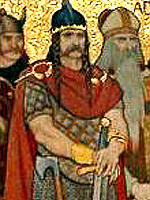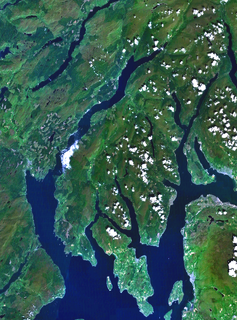Related Research Articles

Kenneth MacAlpin, known in most modern regnal lists as Kenneth I, was a king of the Picts who, according to national myth, was the first king of Scots. He was thus later known by the posthumous nickname of An Ferbasach, "The Conqueror". He became the apex and eponym of a dynasty—sometimes called Clann Chináeda—that ruled Scotland from the ninth- to the early eleventh-century.

Dál Riata or Dál Riada was a Gaelic kingdom that encompassed the western seaboard of Scotland and the north-eastern corner of Ireland, on each side of the North Channel. At its height in the 6th and 7th centuries, it covered what is now Argyll in Scotland and part of County Antrim in Northern Ireland. After a period of expansion, Dál Riata eventually became associated with the Gaelic Kingdom of Alba.

Strathclyde, originally Cumbric: Ystrad Clud or Alclud, was one of the early medieval kingdoms of the Britons in what the Welsh call Hen Ogledd, the Brythonic-speaking parts of what is now southern Scotland and northern England. The kingdom developed during the post-Roman period. It is also known as Alt Clut, a Brittonic term for Dumbarton Castle, the medieval capital of the region. It may have had its origins with the Brythonic Damnonii people of Ptolemy's Geography.
Alpín mac Echdach was a supposed king of Dál Riata, an ancient kingdom that included parts of Ireland and Scotland.
Óengus mac Fergusa was king of the Picts from 820 until 834. In Scottish historiography, he is associated with the veneration of Saint Andrew, the patron saint of Scotland.

Causantín or Constantín mac Fergusa was king of the Picts, in modern Scotland, from 789 until 820. He was until the Victorian era sometimes counted as Constantine I of Scotland; the title is now generally given to Causantín mac Cináeda. He is credited with having founded the church at Dunkeld which later received relics of St Columba from Iona.

Áedán mac Gabráin was a king of Dál Riata from c. 574 until c. 609. The kingdom of Dál Riata was situated in modern Argyll and Bute, Scotland, and parts of County Antrim, Ireland. Genealogies record that Áedán was a son of Gabrán mac Domangairt.

Comgall mac Domangairt was king of Dál Riata in the early 6th century. He was the son of Domangart Réti and grandson of Fergus Mór. The Annals of Ulster report his death in 538, 542 and 545, the Annals of Tigernach in 537.
Fergus Mór mac Eirc was a legendary king of Dál Riata. He was the son of Erc of Dalriada.
The Senchus fer n-Alban is an Old Irish medieval text believed to have been compiled in the 10th century. It provides genealogies for kings of Dál Riata and a census of the kingdoms which comprised Dál Riata.
The Cruthin were a people of early medieval Ireland. Their heartland was in Ulster and included parts of the present-day counties of Antrim, Down and Londonderry. They are also said to have lived in parts of Leinster and Connacht. Their name is the Irish equivalent of Priteni, an ancient name for the Celtic Britons, and was sometimes used to refer to the Picts. However, there is a debate among scholars as to the relationship of the Cruthin with the Britons and Picts.
Óengus son of Fergus, was king of the Picts from 732 until his death in 761. His reign can be reconstructed in some detail from a variety of sources. The unprecedented gains he made, and the legacy he left, mean Óengus can be considered the first king of what would become Scotland.
Uuen (Wen) or Eogán in Gaelic was king of the Picts 837-839.
Conall mac Taidg was a king of the Picts from 785 until 789. Very little is recorded of Conall. He is mentioned twice by the Irish annals, the most reliable source for the history of northern Britain in the years around 800. He also appears in later king lists.

The origins of the Kingdom of Alba pertain to the origins of the Kingdom of Alba, or the Gaelic Kingdom of Scotland, either as a mythological event or a historical process, during the Early Middle Ages.
Domnall mac Caustantín is thought to have been king of Dál Riata in the early ninth century.
The House of Óengus is a proposed dynasty that may have ruled as Kings of the Picts, as well as overlords of the Kings of Dál Riata and possibly of all of northern Great Britain, for approximately a century from the 730s to the 830s AD. Their first ruler of Pictland was the great Óengus I of the Picts, who may be the figure carved into the St Andrews Sarcophagus pictured on the right.

The Scottish Renaissance humanist George Buchanan gave a long list of Scottish Kings in his history of Scotland—published in Latin as Rerum Scoticarum Historia in 1582—most of whom are now considered by historians to be figures of legend, or completely misrepresented. The list went back around 1900 years from his time, and began with Fergus I. James VI of Scotland, who was Buchanan's pupil, adopted the story of Fergus I as his ancestor, and the antiquity of the line was emphasised by the House of Stuart.
References
- ↑ Chatelain, Henri Abraham; Gueudeville, Nicolas (1708). "Atlas historique, ou nouvelle introduction a l'Histoire. Vol.2". Google Books.
- ↑ "Fergus I, King of Scotland (330-305 B.C.)". Royal Collection Trust.
- ↑ "King Fergus I of Scotland". NPG.org.
![]()